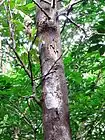Artocarpus hirsutus
Artocarpus hirsutus, commonly known as wild jack,[1] is a tropical evergreen tree species that is native to India, primarily in Kerala, but also in Karnataka, Maharashtra and Tamil Nadu, where it prefers moist, deciduous to partially evergreen woodlands.[3][4]
| Artocarpus hirsutus | |
|---|---|
 | |
| Bark | |
| Scientific classification | |
| Kingdom: | Plantae |
| Clade: | Tracheophytes |
| Clade: | Angiosperms |
| Clade: | Eudicots |
| Clade: | Rosids |
| Order: | Rosales |
| Family: | Moraceae |
| Genus: | Artocarpus |
| Species: | A. hirsutus |
| Binomial name | |
| Artocarpus hirsutus | |
The Artocarpus hirsutus grows in altitudes ranging from sea level to an elevation of 1000 m in places with an annual rainfall of 1500 mm or more. They are endemic to the Western Ghats and are found in its evergreen forests. The canopy tree can reach a height of up to 35 m and about 4.5 m in girth.[5]
The tree is prized for its durable timber which is comparable in quality with teak. The timber was used extensively in the construction of ceilings, door frames and furniture in older buildings, especially in Kerala.[6] The famous snake boats of Kerala are often hewn out of the Aini's wood.[7] 140 tons of A. hisutus wood from Kerala was used for Tim Severin's ship Sohar, in which he traveled from Muscat to Canton in 1980-81.
Its flowers are, unisexual, in axillary inflorescences and its fruits are syncarps and very sweet, changing to an orange hue when ripe. Its simple, alternate leaves will ooze latex if broken. It is harvested for its wood.[3][4]
Fruit
The ripe fruit of A. hirsutus is eaten after removing the spiny outer skin. The structure of the fruit is similar to that of the much larger jackfruit. The seeds are also edible, usually fried as a snack.
Diseases
The important diseases of Artocarpus hirsutus reported from Southern part of India (Kerala state) are Pink disease (Corticium salmonicolor)[8] & Macrophomina leaf spot (Macrophomina phaseolina).[9]
Gallery
 Unripe fruit
Unripe fruit Ripe fruit
Ripe fruit Trunk with fungal infection
Trunk with fungal infection
References
- Barstow, M. & Deepu, S. (2018). "Artocarpus hirsutus". The IUCN Red List of Threatened Species. 2018: e.T61220325A61220328. doi:10.2305/IUCN.UK.2018-1.RLTS.T61220325A61220328.en.
- Encycl. 3(1): 211. 1789 [19 Oct 1789] "Plant Name Details for Artocarpus hirsutus". IPNI. Retrieved January 27, 2010.
- "Artocarpus hirsutus". Germplasm Resources Information Network (GRIN). Agricultural Research Service (ARS), United States Department of Agriculture (USDA). Retrieved January 27, 2010.
- H.S. Suresh, Harish R. Bhat (December 17, 1998). "Flora". Flora of IIS: Centre for Ecological Sciences. Bangalore, India: Indian Institute of Science. Retrieved January 27, 2009.
- http://www.biotik.org/india/species/a/artohirs/artohirs_en.html
- http://parayilat.blogspot.in/2010/11/anjili-tree-of-many-uses.html
- "Archived copy". Archived from the original on 2012-07-25. Retrieved 2012-07-22.CS1 maint: archived copy as title (link)
- http://www.cabdirect.org/abstracts/20083207488.html
- http://www.cabdirect.org/abstracts/20083027095.html
External links
| Wikimedia Commons has media related to Artocarpus hirsutus. |

